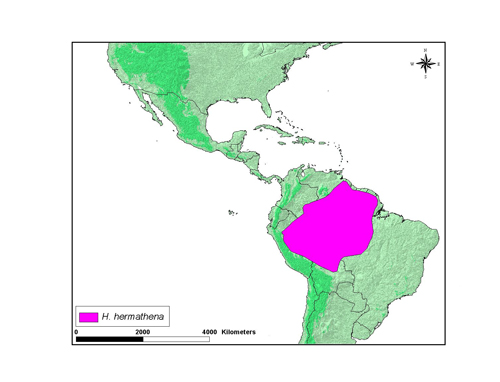Heliconius hermathena
Margarita Beltrán and Andrew V. Z. BrowerIntroduction
Heliconius hermathena is endemic to white sand areas of the Amazon basin. Its ecology is discussed in Brown and Benson (1977). H. hermathena is restricted to certain non-forest habitats in the Brazilian Amazon. One of its four subspecies, H. h. vereatta, is mimetic of sympatric H. m. melpomene and H. e. hydara and is very restricted geographically (Brown and Benson, 1977). The other three are non-mimetic, little differentiated and apparently widespread, but the populations are patchy and in low densities. Their wing colour pattern is black, yellow and red; the forewing is black with red, resembling H. m. melpomene and H. e. hydara, while the hindwing is black with yellow bars and spots, resembling H. charithonia.
Etymology: Herm is a statue consisting of a squared stone pillar with a carved head, usually a bearded Hermes on top; used in ancient Greece as a boundary marker or signpost. Hermathena is a herm of Athena (Hermae).
Characteristics
Early stages: Eggs are yellow and approximately 1.3 x 0.7 mm (h x w). Females usually place 1 to 3 eggs on growing shoots of the host plant. Mature larvae have a red body with black and red spots, black scoli, and red head; length is around 2 cm. Caterpillars are solitary (Brown, 1981).
Geographical Distribution
Heliconius hermathena is distributed from Venezuela to Brazil. The map below shows an approximate representation of the geographic distribution of this species. The original data used to draw these maps are derived from Brown (1979) which is available at Keith S. Brown Jr. (1979). Ecological Geography and Evolution in Neotropical Forests.
Habits
H. hermathena occurs from sea level to 1,000 m in scrub. Usually individuals fly erratically and in the lowerstory. The males sit on female pupae a day before emergence, and mating occurs the next morning, before the female has completely eclosed. Adults roost at night in loose groups lower than 2 m above ground, in leaves twigs or tendrils (Brown, 1981).
Host plant: H. hermathena larvae feed primarily on plants from the subgenus Astrophea (Passifloraceae) (Brown et al. , 1977).
References
Brown KS, Jr., and Benson WW. 1977. Evolution in modern Amazonian non-forested islands: Heliconius hermathena. Biotropica 9: 95-117.
Brown K. S. 1981 The Biology of Heliconius and Related Genera. Annual Review of Entomology 26, 427-456.
Hewitson W C. 1854. Illustrations of new species of exotic butterflies, selected chiefly from the collections of W. Wilson Saunders and William C. Hewitson. London, John Van Voorst.(9): [13-14], [25-26], [83-84], pls. [7], [13], [42] (2 January 1854), (10): [87-90], [97-98], pls. [44-45], [49] (3 April 1854)
Hermae. Classic Encyclopedia. http://www.1911encyclopedia.org/Hermae [Accessed Jul 31, 2008].
Title Illustrations

| Scientific Name | Heliconius hermathena |
|---|---|
| Location | Maues, Amazonas, Brazil |
| Specimen Condition | Live Specimen |
| Identified By | Andrew V. Z. Brower |
| Sex | Female |
| Life Cycle Stage | adult |
| View | dorsal |
| Source | Hermathona Heliconian |
| Source Collection | Neotropical Butterflies |
| Copyright | © 2002 Will Carter |
About This Page

University of Cambridge, Cambridge, UK

Middle Tennessee State University, Murfreesboro, Tennessee, USA
Correspondence regarding this page should be directed to Margarita Beltrán at and Andrew V. Z. Brower at
Page copyright © 2010 and
 Page: Tree of Life
Heliconius hermathena .
Authored by
Margarita Beltrán and Andrew V. Z. Brower.
The TEXT of this page is licensed under the
Creative Commons Attribution-NonCommercial-ShareAlike License - Version 3.0. Note that images and other media
featured on this page are each governed by their own license, and they may or may not be available
for reuse. Click on an image or a media link to access the media data window, which provides the
relevant licensing information. For the general terms and conditions of ToL material reuse and
redistribution, please see the Tree of Life Copyright
Policies.
Page: Tree of Life
Heliconius hermathena .
Authored by
Margarita Beltrán and Andrew V. Z. Brower.
The TEXT of this page is licensed under the
Creative Commons Attribution-NonCommercial-ShareAlike License - Version 3.0. Note that images and other media
featured on this page are each governed by their own license, and they may or may not be available
for reuse. Click on an image or a media link to access the media data window, which provides the
relevant licensing information. For the general terms and conditions of ToL material reuse and
redistribution, please see the Tree of Life Copyright
Policies.
- First online 18 February 2007
- Content changed 12 August 2008
Citing this page:
Beltrán, Margarita and Andrew V. Z. Brower. 2008. Heliconius hermathena . Version 12 August 2008 (under construction). http://tolweb.org/Heliconius_hermathena/72240/2008.08.12 in The Tree of Life Web Project, http://tolweb.org/







 Go to quick links
Go to quick search
Go to navigation for this section of the ToL site
Go to detailed links for the ToL site
Go to quick links
Go to quick search
Go to navigation for this section of the ToL site
Go to detailed links for the ToL site